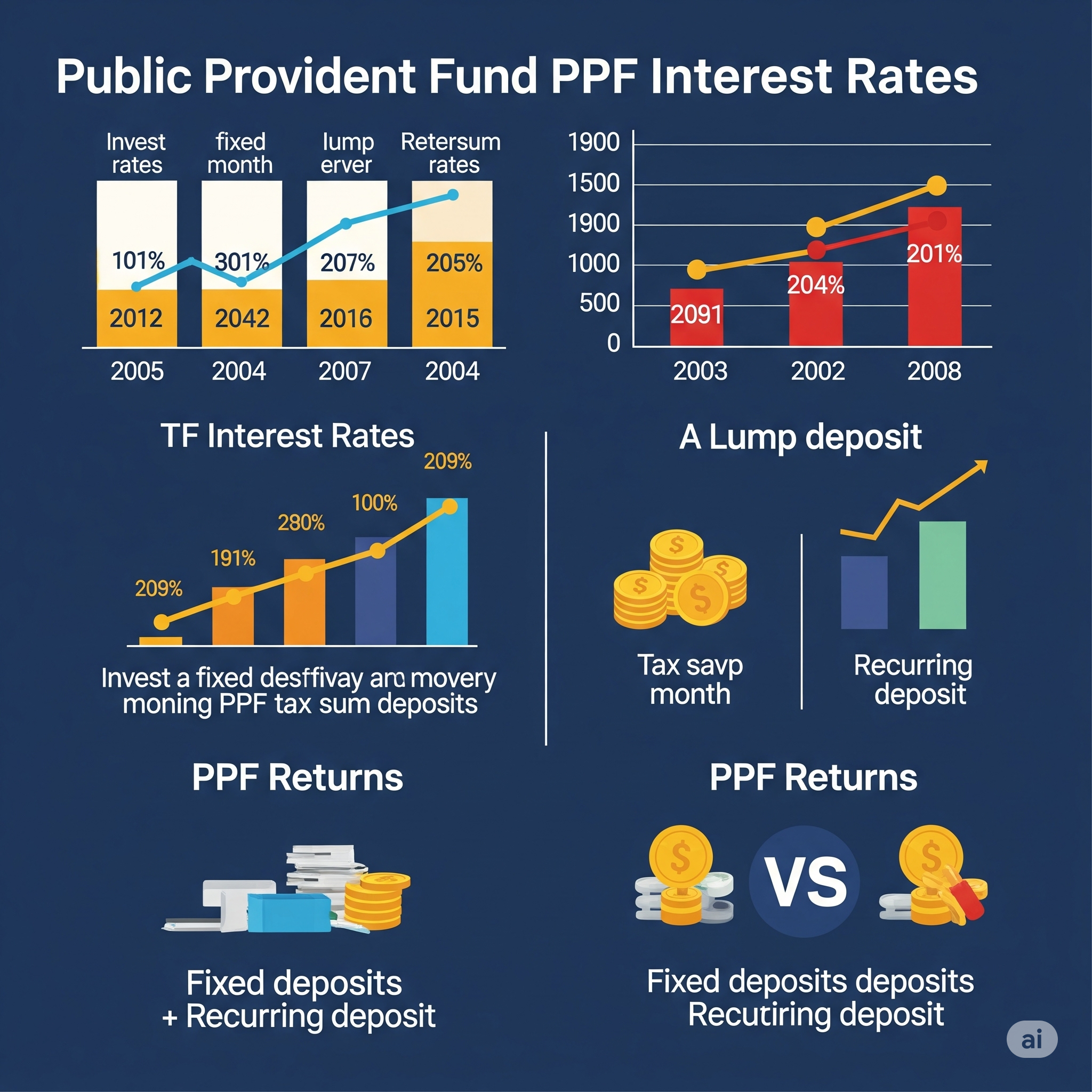The Public Provident Fund (PPF) is a popular long-term investment option in India, known for its tax benefits, safety, and guaranteed returns. With a 15-year lock-in period and EEE tax status, it attracts many investors seeking tax-free interest and maturity amounts.
The PPF interest rate is reviewed quarterly by the government. For the April-June quarter of 2025, it remains unchanged at 7.1% per annum. This scheme offers a unique combination of safety and returns, making it an attractive option for those looking to maximize their savings.

Understanding the current interest rate and how to leverage PPF’s features is crucial for achieving long-term financial goals.
Key Takeaways
- PPF remains a trusted long-term savings option in India.
- The current PPF interest rate is 7.1% per annum for the April-June quarter of 2025.
- PPF offers tax benefits and guaranteed returns.
- Strategic deposit techniques can enhance PPF returns.
- PPF is a viable option for creating a balanced investment portfolio.
- Understanding PPF’s features is key to maximizing savings.
Current PPF Interest Rate in India
Understanding the current PPF interest rate is crucial for individuals looking to maximize their savings in India. The Public Provident Fund scheme is a popular investment option due to its tax benefits and relatively stable returns.
Latest Interest Rate Update for 2025
The latest interest rate for the Public Provident Fund in India has been set at 7.1% for the financial year 2024-25. This rate applies to PPF accounts opened or continued during this period. The rate has remained steady since April 2020, providing a consistent return for investors despite economic fluctuations.
Historical PPF Interest Rate Trends
Over the past decade, the PPF interest rate has shown a gradual decline. The rate was 8.1% in 2013-14 and has decreased to 7.1% in 2024-25, representing a drop of 1%. The historical data reveals that while the rate has decreased, PPF remains a competitive option compared to other savings schemes.
| Financial Year | PPF Interest Rate (%) |
|---|---|
| 01-Apr-24 to 31-Mar-25 | 7.1 |
| 01-Apr-22 to 31-Mar-23 | 7.1 |
| 01-Apr-21 to 31-Mar-22 | 7.1 |
| 01-Apr-20 to 31-Mar-21 | 7.1 |
| 01-Apr-13 to 31-Mar-14 | 8.1 |
The trend indicates that while there have been fluctuations, the rate has been stable at 7.1% since April 2020. This stability is notable despite changes in economic conditions over the same period.
Understanding the Public Provident Fund Scheme
With its attractive interest rates and tax exemptions, the Public Provident Fund (PPF) has emerged as a favored investment option for Indian citizens. The scheme is designed to encourage savings among individuals while providing a safe and secure investment avenue.
What is PPF and How Does It Work?
The PPF is a long-term investment scheme that allows individuals to open an account at designated banks or post offices. To open a PPF account, one needs to make a minimum deposit of Rs.500, with the flexibility to invest up to Rs.1,50,000 in a financial year. The scheme has a fixed maturity period of 15 years, after which account holders can choose to extend it in blocks of 5 years.
Key Features of PPF Accounts
Some of the key features of PPF accounts include:
- Flexibility in deposit frequency, allowing investments in lump sum or installments up to 12 times a year.
- The option to avail a loan facility between the 1st and 5th financial year from the date of opening the account.
- Tax benefits under Section 80C, with interest earned being tax-exempt.
- The ability for parents or guardians to open a PPF account on behalf of a minor, independent of their own account.
Investors can deposit funds into their PPF account via various modes, including online transfers, cheques, demand drafts, or cash payments. It’s also worth noting that an individual can maintain only one PPF account in their name, except for accounts opened on behalf of minors.
| Feature | Description |
|---|---|
| Maturity Period | 15 years, extendable in blocks of 5 years |
| Minimum Deposit | Rs.500 |
| Maximum Deposit | Rs.1,50,000 in a financial year |
| Interest Rate | 7.1% per annum (effective from 1st January 2024) |
| Tax Benefits | Eligible for Section 80C deductions, tax-exempt interest |
“The PPF scheme is an attractive option for those looking for a safe and tax-efficient way to save for the long term.”
How PPF Interest Rates Are Calculated
To make informed decisions about your PPF investment, it’s essential to know how the interest rate is calculated. The Public Provident Fund (PPF) interest rate is calculated on a monthly basis, but it’s compounded annually.
Monthly vs. Annual Interest Calculation Method
The interest on PPF accounts is calculated using the monthly balance, but it’s credited annually. This means that the interest rate is applied to the balance at the end of each month, but the actual crediting of interest happens at the end of the year. Understanding this distinction is crucial for managing your deposits effectively.
Using PPF Calculators for Accurate Projections
A PPF calculator is an indispensable tool for investors. It helps in calculating the maturity amount based on the investment frequency, deposits, and the prevailing interest rate. By using a PPF calculator, you can plan your investment strategy and estimate your returns. For instance, the Bajaj Finserv PPF Calculator allows you to input your investment frequency, annual investment amount, and duration to get an accurate projection of your PPF maturity amount.
Maximizing Returns on Your PPF Investment
To get the most out of your PPF investment, it’s crucial to understand the nuances of deposit timing and frequency. The Public Provident Fund scheme offers flexibility in managing your account, allowing you to make deposits in a manner that suits your financial goals.
Strategic Deposit Timing to Earn Extra Interest
Making a lump sum deposit at the beginning of the financial year can earn interest for the entire year, maximizing your returns. For instance, depositing Rs. 1.5 lakh on April 1st allows you to earn interest on the entire amount for the year.
Optimal Deposit Frequency and Amount
The PPF scheme requires a minimum deposit of Rs. 500 annually to keep the PPF account active, while the maximum investment allowed is Rs. 1.5 lakh per financial year. Investors can choose to make monthly, quarterly, or lump sum deposits, providing flexibility in managing their account. As emphasized by financial experts, “A systematic approach with regular deposits can build disciplined saving habits and provide better average returns.”
Tax Benefits of PPF Investments
One of the most significant advantages of investing in a Public Provident Fund (PPF) is its tax benefits. The PPF scheme is designed to encourage savings while providing investors with substantial tax savings.
Section 80C Deductions for PPF Contributions
Contributions to a PPF account are eligible for tax deductions under Section 80C of the Income Tax Act. This means that the amount you invest in PPF can be deducted from your taxable income, thereby reducing your income tax liability. For instance, if you invest ₹1.5 lakh in PPF, you can claim a deduction of up to ₹1.5 lakh under Section 80C, potentially saving you a significant amount on your taxes.
EEE Status: Tax-Free Interest and Maturity Amount
The PPF scheme enjoys the coveted EEE (Exempt-Exempt-Exempt) tax status. This means not only are the contributions tax-deductible, but the interest earned is also completely tax-free. Moreover, the maturity amount is entirely tax-free at the end of the 15-year lock-in period. This triple tax advantage makes PPF an attractive investment option for those looking to minimize their tax burden while maximizing their savings.
PPF Account Management and Flexibility
Understanding the management and flexibility options in PPF is key to utilizing it effectively. The scheme is designed to be adaptable to the needs of account holders, offering various features that enhance its utility.
Loan and Partial Withdrawal Facilities
PPF accounts offer loan and partial withdrawal facilities to account holders. You can take a loan against your PPF balance from the third to the sixth year. Partial withdrawals are allowed after the fifth year, subject to certain conditions. This flexibility makes PPF a viable option for long-term savings while providing access to funds when needed.
Extension Options After Maturity
Upon maturity, PPF accounts can be extended in blocks of 5 years, with or without continued contributions. This flexibility allows account holders to continue earning interest on their savings without having to close the account. The extension option is particularly useful for those who wish to keep their savings invested for longer periods.
Account Opening and Maintenance Rules
To open a PPF account, individuals can visit designated banks or post offices with required documents. The minimum initial deposit is Rs.500, which can be made via cash, cheque, demand draft, or online transfer. Regular maintenance involves updating the passbook or checking online statements, especially after the annual interest credit.
Conclusion: Is PPF the Right Investment for You?
The PPF remains a cornerstone of long-term savings strategies for many Indian investors due to its guaranteed returns and tax advantages. As a low-risk investment option, it offers a unique combination of safety, tax benefits, and reasonable returns over the long term.
PPF is particularly well-suited for individuals with a long-term financial horizon who value capital preservation and guaranteed returns. The scheme’s triple tax advantage makes it especially valuable for those in higher tax brackets. However, it may not be ideal for investors seeking high growth or those with short-term financial goals.
When evaluating PPF against other savings options, consider your personal risk tolerance, investment timeline, and overall financial goals. Despite fluctuations in interest rates, PPF’s combination of government backing, tax advantages, and consistent returns continues to make it a relevant investment vehicle for millions of Indian savers, making it a valuable addition to a diversified investment portfolio.







